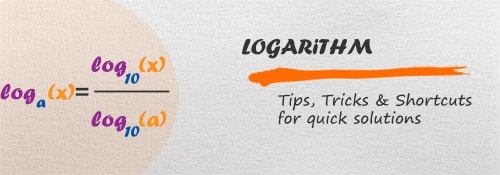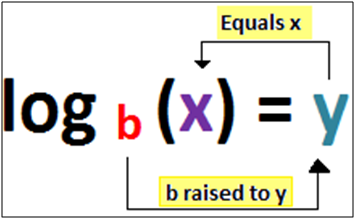
Logarithm - tips, tricks and questions
Logarithms make math easy. Studying this chapter will help you in solving and simplifying complicated numerical expressions. Rules of logarithm can also be used to find the square and square root of numbers.
Important terms: Logarithm: It is the power to which a number must be raised in order to get some other number.Common logarithm:Logarithms with
base 10 are common logarithms.
Common logarithms are written as log
10 x and if any expression is not indicated with a base, then base 10 is considered.
Natural logarithm: Logarithms with
base e are natural logarithms.
Natural logarithms are written as log
ex and denoted as ln (x).
Logarithm of a number contains 2 parts: Characteristic and Mantissa Characteristic is an integral part of logarithm.
Case 1: If number is greater than 1.
In this condition, characteristic is considered as one less than the number of digits in the left of decimal point in the given number.
Example: 256.23
Number of digits to the left of decimal point are 3. Hence, the characteristic is one less than number of digits before decimal points i.e 2.
Case 2: If number is less than 1.
In this condition, characteristic is considered as one more than the number of zeros between decimal point and first digit of the number. It is negative and is denoted as
(One bar)
1 or (Tow bar)
2Example: 0.00735
Number of zeros between decimal point and first significant digit 7 are 2. Hence the characteristic is one more than number of zeros i.e
3Mantissa: It is the decimal part of logarithm. Log table is used to find the mantissa.
Quick Tips and TricksVery Important: If base is not mentioned, then always remember to take it as 10.
Properties of logarithm1) log
xx = 1
2) log
a1 = 0
3) a
logax = x
5) log
a(x
P) = p (log
ax)
| 6) logax = | logbx | = | log x | - - - (Change of base formula) |
| logba | log a |
| 7) loga |  | x |  | = logax – logby - - - - (Division Rule) |
| y |
8) log
a (xy) = log
a x + log
b y
Important points to remember1) Logarithms are opposite to exponentials which means
logs are inverses of exponentials.2) Given logarithmic form can be converted into exponential form as shown below:
b = base y = exponent x = answer Exponential form: by = x Logarithm form: logb (x) = yLog of numbers (2 – 10)
Exponential form: by = x Logarithm form: logb (x) = yLog of numbers (2 – 10) (Must Remember)
Log 2 = 0.301
Log 3 = 0.477= 0.48
Log 4 = 0.60
Log 5 = 0.698 = 0.7
Log 6 = 0.778 = 0.78
Log 7 = 0.845 = 0.85
Log 8 = 0.90
Log 9 = 0.954= 0.96
Log 10 = 1
Finding log without using calculatorThese are very easy methods to find the log of numbers without calculator.
Step 1: You should know all the prime factors of given numbers.
Step 2: Method 2: Log of 4 to 9 can be easily determined if only the
value of log 2 and log 3 is remembered.| Method 1 | Method 2 |
Log of composite number (x) = Sum of logarithms of its prime factors.
Example: Log of 9 =?
If you know the value of log 3, the value of log 9 can be easily determined.
Log 3 = 0.477
Log of 9 = Sum of logarithms of its prime factors.
Log of 9 = log 3 + log 3
= 0.477 + 0.477
= 0.954
Log of 9 = 0.954 | Log 2 = 0.301
Log 3 = 0.477
Log 4 = 2 x log 2 = 0.60206
Log 5 = 1 – log 2 = 0.6989
Log 6 = log 2 + log 3 = 0.778
Log 7 = 0.84510 --- (Remember)
Log 8 = 3 x log 2 = 0.9030
Log 9 = 2 x log 3 = 0.9542 |
Types of QuestionsType 1: Find the value of given expression.
log
2 64
a. 6
b. 8
c. 16
d. 32
View solution Correct Option: (a)
We have to simplify the given expression, which means in exponential form. Remember the tricks discussed above.
Hint:
Logarithm form: logb (x) = y
Exponential form: by = x
Given: log2 64
Let the solution of log2 64 be y.
Log2 64 = y
2y = 64
26 = 64
Therefore, y = 6
| Q 2. log7 |  | 1 |  |
| 2401 |
a. 7
b. -3
c. - 4
d. 9
View solution Correct Option: (c)
We have to simplify the given expression, which means in exponential form. Remember the tricks discussed above.
Hint:
Logarithm form: logb (x) = y
Exponential form: by = x
| Let the solution of log7 |  | 1 |  | be y |
| 2401 |
| log7 |  | 1 |  | = y |
| 2401 |
Therefore,
y=-4
49
log74a. 7
b. 14
c. 16
d. 18
View solution Correct Option: (c)
Hint:
alogax = x, here the base of logax and number which is based to logax are same. i.e. a
Therefore, in the given expression
49log74 = (72)log74
loga(xp) = p(logax)
Carefully understand the simplification done using the properties of logarithm.
(7 2) log74 = (7) (log74)2 = (7) log7(4 2)
We know that, alogax = x
Hence, (7) log7(42) = 42 = 16